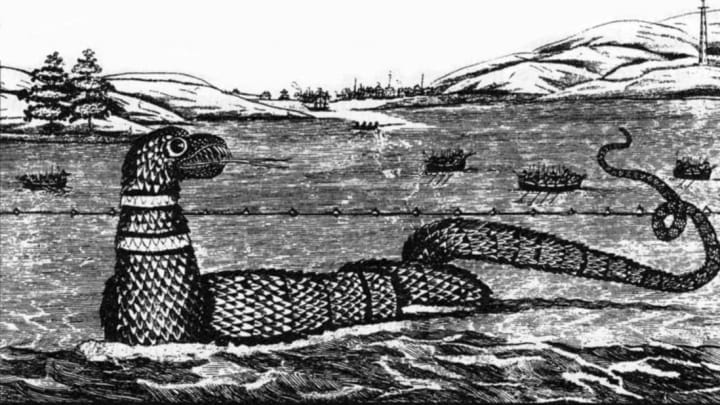Sailing into Massachusetts’s Gloucester Harbor in August 1817, the skipper of a coasting vessel looked across choppy seas and saw something mind-boggling bobbing in the water.
It was approximately 60 feet long with a body composed of humps, each the size of a keg. It was black, shiny, and leathery. It wiggled like a caterpillar. It had a giant head—a serpent's head—with a pair of dark eyes “as large as pewter plates."
The ship's captain couldn't believe his eyes. When he got into town, he spoke with the utmost seriousness as he told other sailors about what he had seen. The news was met with derision and laughter ... until others started seeing the same thing.
"His head appeared to be about the size of a crown of a hat," claimed James Mansfield, one of the men who witnessed the beast. "The shape of his head I cannot describe, and I saw no ears, horns, or other appendages."
"I should judge him between 80 and 90 feet in length," Solomon Allen III, another witness, claimed. “His head formed something like the head of a rattlesnake, but nearly as large as the head of a horse."
Sewall Toppan, a schooner master, summarized the growing mood in Gloucester: "I have been to sea many years, and never saw any fish that had the least resemblance to this animal."
That’s what made the case so unusual, writer Ben Shattuck argued in Salon. “What made these sightings different from the long history of sea monster sightings was that they came from Gloucester fishermen—those who had inherited the oldest fishing port in America, those who knew mostly every fish species off Cape Ann and when each migrated through. More, this ‘serpent’ was in their harbor, right under their noses—something equivalent to a Sasquatch walking across the parking lot of a hunting expo."
As Shattuck explained, local newspapers gobbled up the gossip coming out of Gloucester Harbor. The Boston Weekly Messenger trumpeted the creature’s arrival with the headline “Monstrous Serpent.” The harbor's ferries soon overflowed with tourists, many of whom claimed to see the creature. David Humphreys, a former aide-de-camp for George Washington, said the serpent “was seen by 200, at one time, sporting the whole afternoon, under Wind Mill Point.” According to American Heritage, the creature was seen as far away as Long Island Sound off the coast of Connecticut.
Soon, a large cash reward was offered to anybody who could capture the animal. Fishermen and whalers across New England flocked to Gloucester Harbor to catch it, setting out nets and baiting shark hooks. Locals busily searched the Massachusetts seashore for giant serpent eggs. In Boston, a large shed was presumptively constructed to house the creature's carcass. The serpent, however, proved to be invincible. According to the Essex Register: "Two muskets were fired at it, and appeared to hit it on the head, but without effect. It immediately disappeared, and in a short time was seen a little below, but in the dark we lost sight of him."
The New England Linnaean Society of Boston impatiently waited for a specimen to arrive. In the meantime, they collected first-hand accounts and published a long-winded paper detailing the sightings called Report of a Committee of the Linnaean Society of New England Relative to a Large Marine Animal Supposed to be a Serpent, Seen near Cape Ann, Massachusetts, in August 1817.
Finally, one day, a pitchfork-wielding farmer in Cape Ann stabbed a 4-foot long snake he saw swimming near the shore and brought it to the Linnaean Society. The distinguished group dissected the specimen and decreed that it was the monster’s offspring. They introduced an entirely new genus, Scoliophis (meaning "humped snake" in Latin), and gave the creature a scientific name: Scoliophis atlanticus.
For biologists, it was a short-lived victory. Not long after, a French naturalist showed that the junior specimen was nothing more than a diseased black snake that was common to area. (Overall, European scientists were amused by the news coming out of America, calling the creature—with a wink and a nod—the "Great American Sea Serpent.")
That, of course, still failed to explain the sightings of a much larger creature roving Gloucester’s waters. Certainly, there was something out there—and it returned in 1818 and 1819. But, eventually, Boston's newspapers tired of writing about the strange seaside visitor. According to American Heritage, one exhausted editor told readers, “The existence of this fabulous animal is now proven beyond all chance of doubt.”
With that the story was put to bed, and the creature's identity has remained a mystery ever since.
